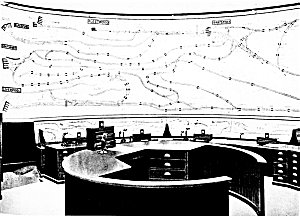 Mr Burtt writes:
Mr Burtt writes:
Sam Hallas' Website
A colleague, Mike Tyrrell, has passed on to me a copy of a book called Control on the Railways, by Philip Burtt, published in 1926, and, as far as I know, now out of print.
Train control can be considered to be a hierarchical step above the signal box. Whereas the signaller controls the movement of individual trains, the controller manages the entire service provided by the railway - ensuring that trains run to the timetable, that staff are available to crew the trains, that roling stock and motive power are in the right places, and so on.
As Mr Burtt makes clear in his introduction, such control has come to rely on first the telegraph and later the telephone.
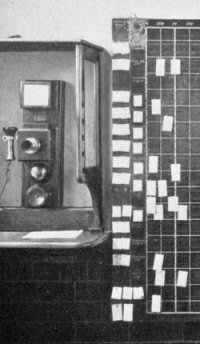
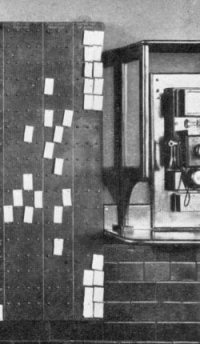
One of the most interesting developments of modern times in connection with the working of our railway systems is the use that has been made of telephonic communication in train working and supervision.
It has introduced a new set of circumstances into the methods of train working on the British railways. It has given a much greater power of con-trol over the manipulation of trains; and it enables the superintendent in charge to supervise train running currently with the actual working instead of by the former method of reviewing past periods.
This not only makes for greater efficiency in getting trains - goods trains especially - more expeditiously over the line, but it has placed a new instrument in the hands of the train operator whose power and effect are only just beginning to be realised So far it has` only been partially installed upon our railways, but it seems likely that it will in the future have much greater effect upon the railway organisations than it has had up to date, and it has already had no small effect where it has been introduced.
So complete are the changes in method that have been brought about that the word "control," when applied to train working, has become invested with quite a new - a technical - meaning. It is used to describe the particular adaptation of telephones and train control boards which constitute the equipment of a centralised train control office.
However, my purpose is not to give you a discourse on train control, but to share some of the images in the book depicting a bygone era when control relied on handwritten tickets and the telephone.
The illustrations above show part of the train board, used in connection with freight train working at Masborough District Control Office. The telephone has a fixed back transmitter and butterstamp pattern receiver, which has been carelessly hung upside down in its rest on the left. A trembler bell and call button are used for signalling. It's a pity the photographer couldn't include more of the phone on the right. I've left out the middle part showing the train board, since the phones are much more interesting.
Train control is an expression which has, during recent years, come to have, a special and quite technical meaning as the system under which, by a centralised and co-ordinated system of telephones, the whole supervision of the train working becomes centralised in and administered from a central office, concurrently with the actual operations and movements on the line at the time.
This supervision and administration of train control by telephone is so revolutionising the methods of management that its application goes to the root of almost every question of economy and efficiency in train working.
The detailed methods of carrying out the control system selected for application, and especially the contingent rearrangement of staff and the duties appropriate to each grade of servant or officer, constitute not only a problem, but a set of problems the bearings of which it is essential should be grasped by all who are occupying, or hoping to occupy, any position of responsibility in connection with train operating upon a railway system. The problems and principles involved are of absorbing interest also to the general student of transport.
The picture shows the Chief Controller's desk and equipment, showing also a portion of the control map in the Divisional Control Office of the Lancashire and Yorkshire Railway at Manchester Victoria. Note the candlestick telephone instruments on the desks and the switchboards for connecting lines. Click on the image for a larger view.
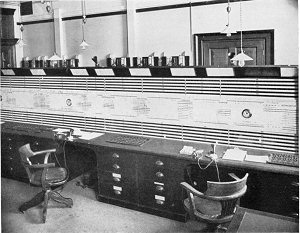
The picture shows the London and North Eastern Railway train control board at York. The controllers used the operators head and breast sets in association with the keys set into the desk, leaving both hands free. A schematic diagram of the track is displayed on the board behind the desk.
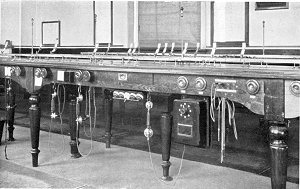
Passenger Train Control, not captioned, but the text states it is at Derby. Typical 1920s brass and ebonite handsets hang from hooks at the front. Central are a set of tumbler switches which appear to be ganged together by a rod. To the right one handset is linked to a selector switch and far right a set of jacks and cords for connecting to incoming circuits. Centre right is selector box which appears to be a Great Western selective telephone as can be seen at the Kidderminster museum.
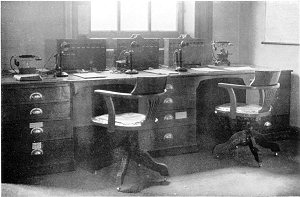
[Right]The Traffic Control Office at York again. An assortment of telephone types on display here. A skeleton magneto type at the far right, candlesticks centre and an odd unit with handset at the left. The photo is a bit fuzzy, so you can't see what the units behind the telephones are. They don't look like switchboards and are more likely to be Western Electric key cases.
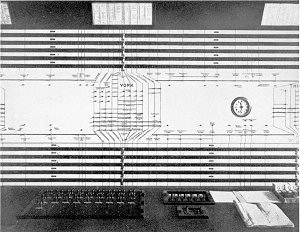
[Left] The Selective Telephone keys are more visible on this close up of the York board showing the York area.
One thing I've been wondering is where all the people are. Who was running the railway while these photographs were being taken?
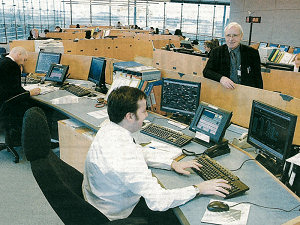
And this is what railway control looked like at the newly opened Saltley Control Centre in 2003. The telephones are worked from the small touch-screen between the two larger monitors. [Picture from Railnews] There are more pictures of Control Offices from the 1940s and 50s in the Peel-Connor/ GEC Picture Gallery
Next: STC Control Telephone System
Reference: Control on the Railways, Philip Burtt, George Allen & Unwin, 1926,
Text © Sam Hallas, revised 2009, with additional information from from Mike Tyrrell.